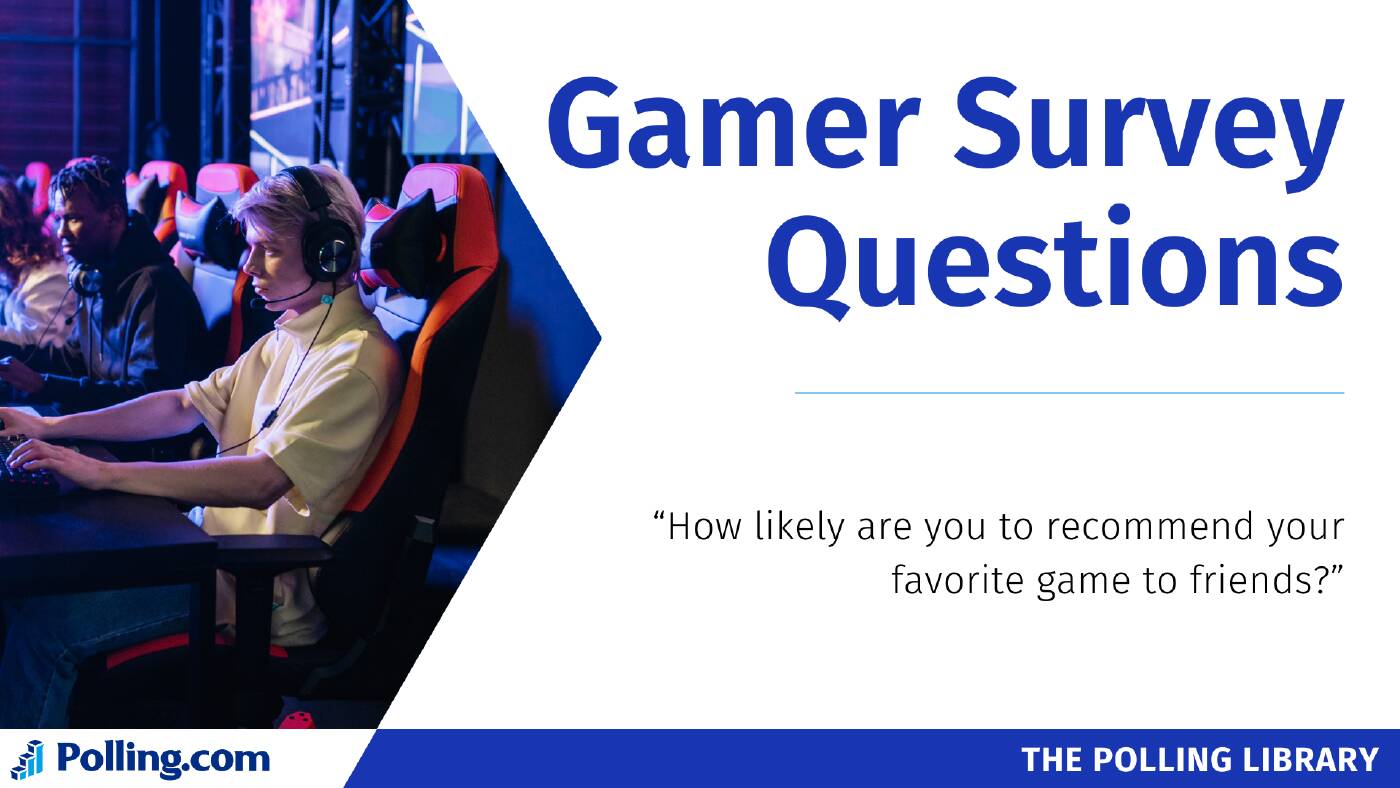
Gaming Surveys Questions: 15 Questions to Ask Gamers for Insights
Who would have anticipated that thoughtfully designed gaming survey questions could unlock such valuable insights?
By gathering direct player feedback, these surveys reveal critical information about motivations, preferences, and expectations.
Gaming surveys empower developers to create more engaging experiences while equipping businesses to foster customer loyalty and drive growth in a competitive industry.
This article will explore how intelligently crafted gaming survey questions for gamers can especially be a game-changer in dominating the gaming industry!
What Well-Crafted Gaming Survey Questions Can Do
A thoroughly designed gaming survey with well-crafted gaming questions conducted within the gaming community is a powerful tool for business owners and also developers looking to make their mark. The benefits of this approach are manifold:
- Targeted Feedback: Surveys provide direct feedback from the people who matter most—your players. This feedback can guide the development process, marketing strategies, and customer support improvements.
- Trend Identification: Understanding emerging trends allows businesses to stay ahead of the curve, whether it’s a spike in interest for certain game genres or a shift in preferred gaming platforms.
- Consumer Behavior Insights: Analyzing how as well as why gamers spend money, the type of content they prefer, and their playing habits can inform more effective monetization strategies and content creation.
- Enhanced Engagement: By engaging with the gaming community through surveys, companies can build stronger relationships with their audience, fostering loyalty and increasing retention rates.

Detailed List of Questions for Gaming Surveys and Insights
Demographic
Understanding the basic demographic makeup of your audience is foundational for any targeted marketing strategy or content development plan. These questions certainly help to segment your audience, making it easier to tailor experiences that resonate on a personal level.
Question #1: What is your age group?
- Tip: Use a multiple-choice format with predefined age ranges to make data analysis easier.
- Question Type: Multiple Choice
- Insight: This question to survey gamers helps tailor content and also marketing strategies to specific age groups. Therefore, making them more effective by aligning with the preferences and behaviors of different demographic segments.
Question #2: What platform do you prefer for gaming?
- Tip: Offer options for all major platforms and include an “Other” option to capture niche preferences.
- Question Type: Multiple Choice
- Insight: Indeed platform preference informs development priorities and marketing strategies, ensuring resources are allocated effectively to target the platforms where your audience is most active.
Gaming Habits
Analyzing gaming habits provides insights into the frequency, duration, and preferences of gameplay, thus, offering a glimpse into the engagement levels and interests of your audience.
Question #3: What type of games do you usually play?
- Tip: List popular genres as options and include a choice for “Other” with a prompt to specify, capturing emerging or niche interests.
- Question Type: Multiple Choice
- Insight: Understanding preferred genres allows developers and marketers to focus on the most popular types of games following to aligning product offerings with market demand.
Question #4: How often do you play games in a week?
- Tip: Define specific ranges (e.g., 1-3 times, 4-7 times) to get quantifiable data that can be easily segmented.
- Question Type: Multiple Choice
- Insight: This question segments your audience by engagement level, hence enabling more tailored communication and promotions to match user activity patterns.
Spending Habits and Experience
This category dives into how much players are willing to spend on their hobby and their satisfaction levels with their investments, critical for developing pricing strategies and also understanding consumer value perception.
Question #5: How much do you spend on games monthly?
- Tip: Consider including ranges for spending (e.g., $0, $1-$20) and an option for specifying an exact amount to capture a broad spectrum of spending behaviors.
- Question Type: Multiple Choice with an open-ended option
- Insight: Insights into spending habits guide pricing strategies and promotional offers, aiming to maximize revenue while maintaining high levels of customer satisfaction.
Question #6: How likely are you to recommend your favorite game to friends?
- Tip: Use a scale from 0 to 10 to gauge loyalty and satisfaction. Provide clear guidance on what each end of the scale represents.
- Question Type: Scale (0-10)
- Insight: A measure of player loyalty and satisfaction, the Net Promoter Score (NPS) is pivotal for gauging a game’s word-of-mouth potential and overall success in the market.
Features and Improvements
Insights into which game features are most important and desired improvements can directly influence development priorities. This ensures that updates align with player expectations.
Question #7: What is the most important feature of a game for you?
- Tip: List common features (gameplay, storyline, graphics) as multiple-choice options and include an “Other” choice with a prompt for specifics.
- Question Type: Multiple Choice
Question #8: What improvements would you like to see in your current favorite game?
- Tip: Use an open-ended question to encourage detailed feedback, providing valuable insights into specific areas for enhancement.
- Question Type: Open-ended
- Insight: Direct feedback on desired improvements informs future game updates and also features, aligning product development more closely with user expectations.
Future Intentions
Questions to survey gamers in particular to this category aim to understand the future actions and preferences of gamers. It provides data of their willingness to make in-game purchases and their openness to trying new games.
Question #9: Have you ever made an in-game purchase? If so, what motivated you to make the purchase?
- Tip: Start with a yes/no question followed by an open-ended follow-up for those who answer affirmatively, to capture motivations behind spending.
- Question Type: Yes/No followed by Open-ended
- Insight: Unpacking the motivations behind in-game purchases can refine monetization strategies, ensuring they align with what genuinely engages and excites your audience.
Question #10: What discourages you from trying new games?
- Tip: Provide common reasons as multiple-choice options and include an “Other” choice with space for specifics, to identify barriers effectively.
- Question Type: Multiple Choice
- Insight: Identifying barriers to trying new games enables targeted strategies to overcome these hurdles, making new games not only more appealing but also more accessible.
Discovery and Community
Understanding how gamers discover new games and the importance of community can guide marketing strategies and the development of social features within games.
Question #11: How do you usually discover new games?
- Tip: Offer multiple channels as options (social media, friend recommendations, etc.) to identify the most effective discovery pathways.
- Question Type: Multiple Choice
- Insight: Knowing how players discover new games indeed optimizes marketing spend, focusing on the most effective channels for engaging the target audience.
Question #12: How important is the community aspect in the games you play?
- Tip: Use a Likert scale (e.g., 1-5) to quantify the importance of community features, providing insights into social engagement preferences.
- Question Type: Scale (1-5)
- Insight: The importance of community and social features can guide decisions on implementing or enhancing these elements to boost user retention and satisfaction.
Gameplay and Content
Feedback on gameplay length and also narrative features can inform content development. This ensures that games meet or exceed player expectations for engaging and satisfying experiences.
Question #13: How do you feel about the length of your favorite games?
- Tip: Offer options like “Too short,” “Just right,” and “Too long” to gauge player satisfaction with game length.
- Question Type: Multiple Choice
- Insight: Player preferences on game length can influence the scope of content development. Moreover, it ensures that games meet or exceed expectations in terms of engagement and value.
Question #14: What features do you look for in a game’s story or narrative?
- Tip: Use an open-ended format to allow for detailed responses, giving developers insight into the storytelling elements players find most compelling.
- Question Type: Open-ended
- Insight: Understanding what players value in game narratives can certainly guide storytelling efforts, making games more compelling and immersive.
Question #15: Would you be interested in participating in game beta tests?
- Tip: A simple yes/no question can help identify a pool of engaged users interested in contributing to the game development process.
- Question Type: Yes/No
- Insight: Gauging interest in beta testing helps to establish a community of engaged testers. This community provides valuable feedback, improving game quality before its release.

Final Thoughts
Gaming Surveys offer a direct line to the heart of the gaming community. It provides insights that can shape the future of gaming experiences. The above outlined 15 questions for surveying gamers mark the starting point. Furthermore, they lay the groundwork for an in-depth investigation into the needs, preferences, and behaviors of gamers.
Indeed, armed with this knowledge, businesses can craft gaming experiences that are more engaging, enjoyable, and successful, resonating deeply with their target audience. This will foster growth and innovation within the gaming industry.
